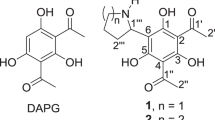Summary
The structure of four new pyoverdins (Pf12-IA, -IIA, -IB und IIB) isolated from the culture medium ofPseudomonas fluorescens 12 was elucidated by combination of spectroscopic methods and degradation reactions. The pyoverdins comprise (1S)-5-amino-2,3-dihydro-8,9-dihydroxy-1H-pyrimido[1,2-a]quinoline-1-carboxylic acid whose amino group carries a 3-carboxypropanoyl-(IA), succinamoyl- (IIA), 4-carboxy-4-oxobutanoyl- (IB) or L-4-amino-4-carboxybutanoylresidue (II B) and whose carboxyl group is bound amidically to the N-terminus of D-Ser-L-Lys-Gly-
. According to the short-hand-nomenclature suggested in [2, 3] the pyoverdins may be described as pyoverdin-Q-sKGO′sSGK*o′ES*-SUC(IA), pyoverdin-Q-sKGO′sSGK*o′-ES*-SUCA (IIA), pyoverdin-Q-sKGO′sSGK*o′ES*-KGL (IB) and pyoverdin-Q-sKGO′sSGK*o′ES*-GLU (IIB). The pyoverdins described here possess the most complex structure encountered so far as their peptide part comprises eleven amino acids and the cyclo-tetrapeptide substructure. In addition, they are of special interest as for the first time glutamic acid could be identified as a chromophore side chain which is the key compound for the citric acid cycle to which belong all dicarboxylic acids found so far in pyoverdins.
Similar content being viewed by others
Abbreviations
- ASK:
-
Acylseitenkette
- Chr:
-
Chromophor1 a
- (HO)Chr:
-
Chromophor1 b
- Dns:
-
Dansyl-Rest
- DP:
-
Dansylpeptid
- EDTA :
-
Ethylendiamintetraessigsäure
- FAB:
-
Fast Atom Bombardment (PI=positive Ionen)
- (HO)Orn:
-
N5-Hydroxyornithin
- (CHO, HO)Orn:
-
N5-Formyl-N5-hydroxyornithin
- PITC :
-
Phenylisothiocyanat
- RP-HPLC:
-
Reversed-Phase High Performance Liquid Chromatography
- Kgl:
-
α-Ketoglutarsäure bzw. 4-Carboxy-4-oxobutanoyl-Rest
- R t :
-
Retentionszeit
- Suc:
-
Bernsteinsäure bzw. 3-Carboxypropanoyl-Rest
- Suca:
-
Succinamoyl-Rest
- Suci:
-
Succinimido-Rest
- TAB :
-
Trifluoracetyl-n-butylester
- TEA :
-
Triethylamin
Literatur
Teil XLVI der Reihe “Bakterieninhaltsstoffe”. Für Teil XLV s. Taraz K., Tappe R., Schröder H., Hohlneicher U., Gwose I., Budzikiewicz H., Mohn G., Lefèvre J. F. (1991) Z. Naturforsch.46c: 527
Briskot G., Taraz K., Budzikiewicz H. (1989) Liebigs Ann. Chem.: 375
Mohn G., Taraz K., Budzikiewicz H. (1990) Z. Naturforsch.45b: 1437
Demange P., Wendenbaum S., Bateman A., Dell A., Abdallah M. A. (1987) Bacterial Siderophores: Structure and Physicochemical Properties of Pyoverdins and Related Compounds. In: Winkelmann G., van der Helm D., Neilands J. B. (ed.) Iron Transport in Microbes, Plants and Animals. VCH, Weinheim, S. 167
Demange P., Bateman A., Mertz C., Dell A., Piemont Y., Abdallah M. A. (1990) Biochemistry29: 11041
Poppe K., Taraz K., Budzikiewicz H. (1987) Tetrahedron43: 2261
Teintze M., Hossain M. B., Barnes C. L., Leong J., van der Helm D. (1981) Biochemistry20: 6447;
Teintze M., Leong J. (1981) Biochemistry20: 6457
Yang C. C., Leong J. (1984) Biochemistry23: 3534
Buyer S. J., Wright J. M., Leong J. (1986) Biochemistry25: 5492
van der Hofstad G. A. J. M., Marugg J. D., Verjans G. M. G. M., Weisbeek P. J. (1986) Charakterization and Structural Analysis of the Siderophore Produced by the PGPRPseudomonas putida Strain WCS 358. In: Swinburn T. R. (ed.). Iron, Siderophores and Plant Diseases. Plenum Press, New York, S. 71
Pesmark M., Frejd T., Mattiasson B. (1990) Biochemistry29: 7348
Hohnagel D., Meyer J. M. (1988) J. Bacteriol.170: 4865
Schäfer H., Taraz K., Budzikiewicz H., Z. Naturforsch. (1991)46c: 398
Briskot G., Taraz K., Budzikiewicz H. (1986) Z. Naturforsch.41c: 497
Meyer J. M., Abdallah M. A. (1978) J. Gen. Microbiol.107: 319
Offort R. E. (1966) Nature211: 591
Wendenbaum S., Demange P., Dell A., Meyer J. M., Abdallah M. A. (1983) Tetrahedron Lett.24: 4877
Leimer K. L., Rice R. H., Gehrke C. W. (1977) J. Chromatogr.141: 121
Copper A. J. L., Ginos J. Z., Meister A. (1983) Chem. Rev.83: 321
Anderegg G. A., L'Epplatenier F., Schwarzenbach G. (1963) Helv. Chim. Acta46: 1409
Briskot G. (1988) Dissertation. Univ. Köln
Wüthrich K. (1976) NMR in Biological Research: Peptides and Proteins. North-Holland, Amsterdam
Breitmaier E., Voelter W. (1987) Carbon-13 NMR Spectroscopy. VCH, Weinheim
Bundi A., Wüthrich K. (1979) Biopolymers18: 285
Rabenstein D. L., Sayer T. L. (1976) J. Magn. Res.24: 27
Michels J., Benoni H., Briskot G., Lex J., Schmickler H., Taraz K., Budzikiewicz H., Korth H., Pulverer G., Z. Naturforsch. (im Druck)
Taraz K., Seinsche D., Budzikiewicz H., (1991) Z. Naturforsch.46c: 522
Meister A. (1953) J. Biol. Chem.200: 571
Jen J., Knoche W. (1969) Ber. Bunsenges. Phys. Chem.73: 539
Copper A. J. L., Redfield A. G. (1975) J. Biol. Chem.250: 527
Otani T. T., Meister A. (1957) J. Biol. Chem.224: 137
Viswanathan T. S., Johnson R. E., Fisher H. E. (1982) Biochemistry21: 339
Demange P., Wendenbaum S., Linget C., Mertz C., Cung M. T., Dell A., Abdallah M. A. (1990) Biol. Metals3: 155
Hersh L. B. (1971) Biochemistry10: 2884
Mix H. (1961) Z. physiol. Chem.325: 106;
Mix H. (1961) Z. Physiol. Chem.323: 173;
Nakada H. J., Winehouse S. (1953) J. Biol. Chem.204: 831
Serjeaut E. P., Dempsey B. (1979) Ionisation Constants of Organic Acids in Aqueous Solution. Pergamon Press, Oxford
Kolasa T. (1983) Tetrahedron39: 1753
Keller-Schierlein W., Deér A. (1963) Helv. Chim. Acta46: 1907
Tapuhi Y., Schmidt D. E., Lindner W., Karger B. L. (1981) Anal. Biochem.115: 123
Bax A., Freeman R. (1981) J. Magn. Res.44: 542
Bodenhauser G., Freeman R. (1977) J. Magn. Res.28: 471
Biemann K., Martin S. A. (1988) Mass Spectrom. Rev.6: 1
Roepstorff P., Fohlmann J. (1984) Biomed. Mass Spectrom.11: 601
Author information
Authors and Affiliations
Rights and permissions
About this article
Cite this article
Geisen, K., Taraz, K. & Budzikiewicz, H. Neue Siderophore des Pyoverdin-Typs ausPseudomonas fluorescens . Monatsh Chem 123, 151–178 (1992). https://doi.org/10.1007/BF01045308
Received:
Accepted:
Issue Date:
DOI: https://doi.org/10.1007/BF01045308




